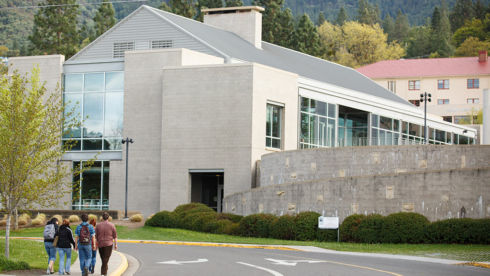ABOUT THIS SERIES: This story launches a series in collaboration with the Ashland Daily Tidings spotlighting the work, research and experiments taking place in laboratories on the Southern Oregon University campus. During the year, these invention centers and their specialized equipment are only accessible to university students, faculty and staff. But on May 15, dozens of departmental labs and art studios will be open to the public during the fifth annual Southern Oregon Arts and Research open house. For more information about SOAR activities, performances and presentations, call 541-552-6816 or visit www.sou.edu/soar.
“We have some pretty cool prints in here,” Sarah Senter says as she walks through Southern Oregon University’s printmaking lab before stopping at a large stack of drying racks.
Carefully lifting up one rack at a time, she finds the print she is looking for: a black-and-white negative of a dead robin, wings spread and head cocked to the side. Senter explains it is the work of one of her classmates, Eden Redmond.
Redmond found the dead bird a couple of days before, brought it to the lab, inked it up, arranged it on the paper and then pressed it like a stamp. The result is a stark image of a bird, delicately arrayed on the canvas.
Every day, students can be found in SOU’s printmaking lab drawing, cutting, inking and pressing. Sometimes what ends up on the drying rack is a small square of paper crisscrossed with lines and blotches of ink, the outcome of somebody testing out a new technique. Other times, it’s a negative of a dead robin.
Senter says that it takes a lot of patience to create a print because of all of the steps involved.
“It’s very much an art where you need to love the process as well as the finished product,” she says.
Creating a typical intaglio print consists of several steps, Senter says. First, the image is etched into a printing plate covered in resin or an acid-resistant wax material. The etched lines cut through the resin or wax on the plate to reveal the metal underneath. The plate is then submerged in an acid bath, where the exposed metal is eaten away. At SOU, the less-toxic liquid rust is used instead of acid. The whole plate is inked up and then wiped off, leaving only the ink in the carved grooves. The plate is pressed in one of SOU’s several large presses, each of which generates between 500 to 1,000 pounds of pressure. Finally, an image is created on the substrate, or material being printed on, and is put on a rack to dry.
Senter says these are only a few of many different processes used in printmaking. For example, for her experimental exhibition, she didn’t use any plates or presses at all, simply rolling the ink directly onto the substrate.
“It’s a medium that doesn’t allow you to be too impetuous,” explains Tracy Templeton, the SOU printmaking instructor. “It’s indirect mark-making.”
Senter came to SOU from Western State College of Colorado after a friend told her that the printmaking lab at SOU is better equipped, larger and has more students.
“I went from Portland to Western State, and I was told, ‘What are you doing here? Go back to Oregon,'” she says. “There’s a lot more space to work in here. It feels huge.”
Senter also appreciates the nontoxic, mostly water-based materials and processes used in the SOU print lab. All pigments are soy-based. Vinegar and Simple Green, a nontoxic cleaning agent, are used to clean the printing plates.
“There are all different sorts of fun ways to die in a printmaking lab,” she says, referring to the toxic chemicals used in traditional labs. “I had a job in a print shop that was very toxic. That’s a really big deal, not having to get cancer from your art.”
Printmaking instructor Templeton says most schools enforce safer practices but it’s unusual to rely mostly on water-based materials. “I have people come here specifically for it, because they have dermatitis or asthma,” she says.
Peg Sjogren, chairwoman of the art department, says prospective students who tour the campus appreciate the quality of the art facilities and the one-on-one time students have with instructors.
“Having a center like this is pretty extraordinary, especially right next to a museum of art,” she says, “because art departments are often stuck in the basement or on the outskirts. I think we are very lucky.”


